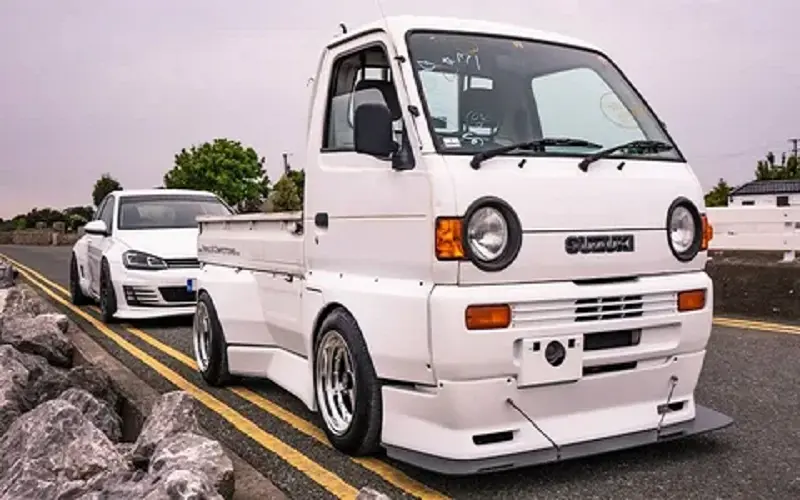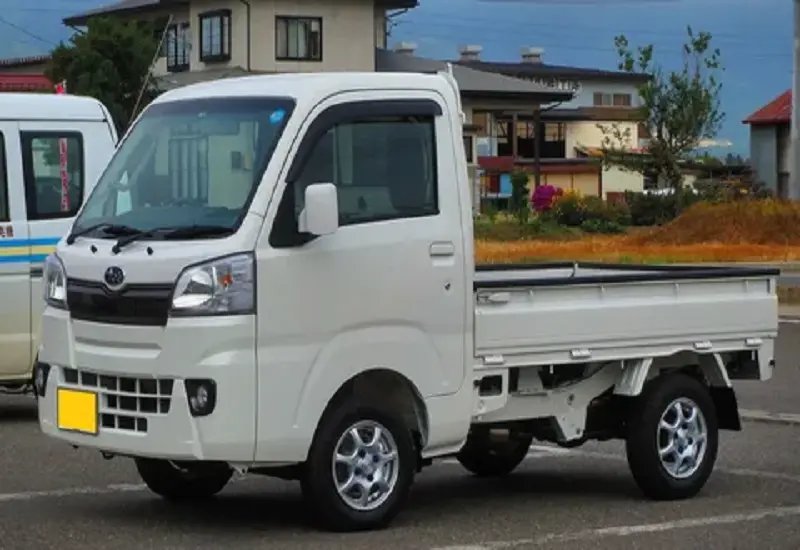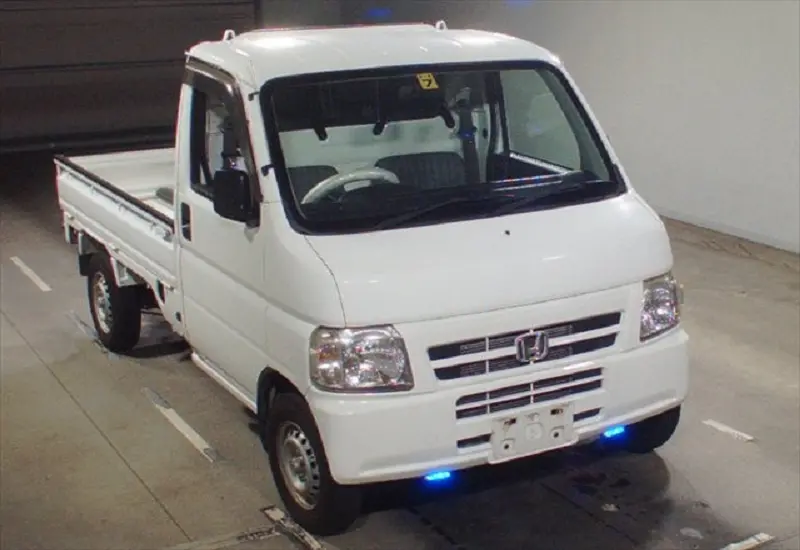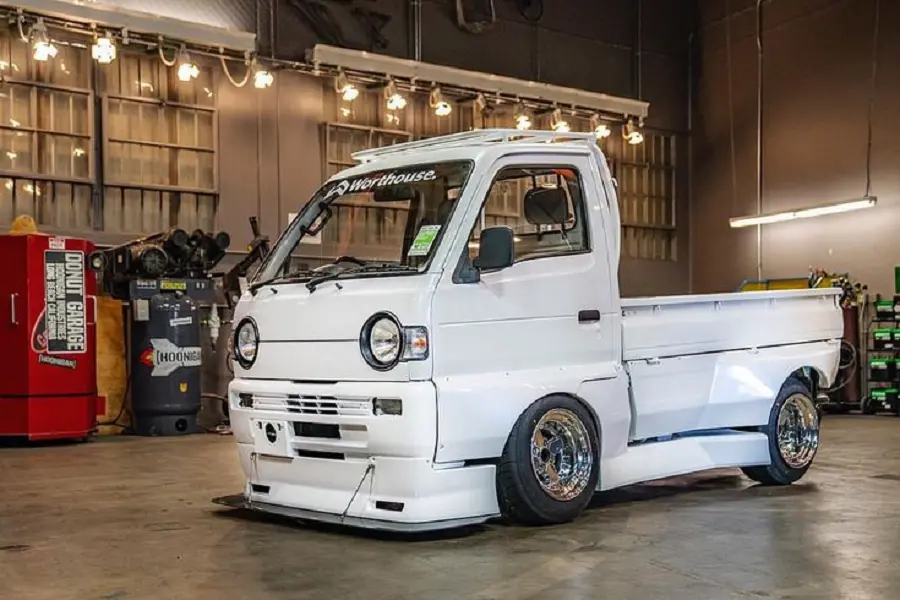Unlocking the Unexpected Advantages of Kei Trucks in the U.S. Market
Introduction
In the vast landscape of transportation options, a unique class of vehicles has quietly captured the attention of a growing number of American consumers – the kei truck. Defying conventional notions of what a “truck” should be, these compact, fuel-efficient powerhouses offer a surprising array of benefits that challenge the status quo.
K trucks, also known as “keijidōsha” in Japan, are a special category of microvehicles designed to navigate the narrow streets and congested urban landscapes of the Land of the Rising Sun. With their diminutive dimensions and efficient engines, these pint-sized workhorses have long been a familiar sight on Japanese roads. However, their presence in the United States has often been shrouded in misconceptions and regulatory hurdles.
This comprehensive blog post aims to shed light on the unexpected advantages of kei trucks and why they deserve a closer look from American consumers. From their unparalleled maneuverability to their exceptional fuel economy and versatility, we’ll explore the key factors that make these compact haulers a compelling option in the U.S. market.
The Essence of Kei Trucks: More Than Just Small Vehicles
Kei trucks, a unique automotive innovation from Japan, represent far more than miniature transportation. These compact utility vehicles embody engineering efficiency, economic practicality, and cultural ingenuity.
Historical Origins
Post-World War II Japan faced severe economic constraints and limited infrastructure. The government strategically introduced kei vehicle regulations to support small businesses and rural communities, creating a vehicle category that would transform transportation.
Defining Characteristics of K Trucks
Kei trucks are precisely defined by strict regulatory parameters:
- Engine Size: Maximum 660cc
- Width: Under 1.48 meters
- Length: Under 3.4 meters
- Height: Approximately 2 meters
Regulatory Landscape: Navigating Complex Compliance

U.S. Import Challenges
Importing k trucks into the United States involves significant hurdles:
| Regulatory Aspect | Detailed Requirements |
| DOT Safety Standards | Extensive modification needed |
| EPA Emissions Regulations | Rigorous compliance protocols |
| Import Restrictions | 25-year exemption rule applies |
The 25-Year Import Exemption Pathway
This unique provision allows older kei trucks to bypass modern safety and emissions standards, creating a niche market for collectors and enthusiasts.
Technical Mastery: Engineering Behind K Trucks
Powertrain Specifications
Kei truck engines showcase remarkable engineering:
- Displacement Range: 660cc
- Horsepower: 40-65 hp
- Fuel Options: Gasoline, limited diesel variants
- Transmission Types: Manual and automatic
Utility and Performance Metrics
Despite compact dimensions, these vehicles offer impressive capabilities:
- Payload Capacity: 350-450 kg
- Cargo Bed Length: 1.5-2 meters
- Maneuverability: Exceptional in tight spaces
Versatile Applications Across Industries
Agricultural Sector Utilization
Farmers leverage k trucks for:
- Minimal operational costs
- Navigation through narrow rural paths
- Flexible cargo handling
- Low maintenance requirements
Urban Logistics and Delivery
Kei trucks excel in metropolitan environments by:
- Solving parking challenges
- Minimizing fuel consumption
- Providing efficient transportation
- Supporting small business logistics
Size and Maneuverability
One of the most striking features of kei trucks is their compact size. Defined by strict regulations in Japan, these vehicles are required to have a maximum length of 3.4 meters (11.2 feet), a width of 1.48 meters (4.9 feet), and a height of 2 meters (6.6 feet). This diminutive stature is a far cry from the hulking proportions of traditional American pickup trucks.
This compact footprint offers several distinct advantages for urban and suburban dwellers. Navigating tight city streets, squeezing into cramped parking spaces, and maneuvering through congested traffic become effortless tasks for kei truck owners. The ability to easily access alleys, back roads, and crowded job sites sets these mini-haulers apart from their full-size counterparts.
“The maneuverability of my kei truck has been a game-changer for my landscaping business. I can access hard-to-reach areas and seamlessly weave through traffic that would be a nightmare for a traditional pickup.” – James, Small Business Owner
Furthermore, the diminutive size of kei trucks translates to enhanced visibility and a tighter turning radius, providing drivers with a heightened sense of control and confidence on the road. This makes them particularly well-suited for urban settings, where parking challenges and narrow streets can be a constant source of frustration for larger vehicle owners.
Fuel Efficiency and Low Operating Costs
Another standout feature of kei trucks is their exceptional fuel efficiency. Powered by compact engines typically ranging from 550cc to 660cc, these microvehicles boast impressive fuel economy figures that leave their full-size counterparts in the dust.
Economic and Environmental Considerations

Cost-Effectiveness Analysis
| Economic Factor | Kei Truck Advantage |
| Purchase Price | Significantly lower |
| Fuel Efficiency | 40-50 miles per gallon |
| Insurance Costs | Reduced premium rates |
| Maintenance Expenses | Lower than standard trucks |
Sustainability Impact
K trucks contribute to environmental goals through:
- Reduced carbon emissions
- Lower manufacturing resource consumption
- Efficient urban mobility solutions
The Suzuki Carry, a popular kei truck model, boasts an impressive fuel economy of 43 mpg in the city and 37 mpg on the highway. In contrast, a full-size Ford F-150 pickup with a 2.7L EcoBoost V6 engine manages only 20 mpg in the city and 26 mpg on the highway.
This significant difference in fuel efficiency translates to substantial cost savings for kei truck owners. With the average price of gasoline hovering around $4 per gallon in the United States, the fuel cost savings can quickly add up, especially for those who rely on their vehicles for frequent, high-mileage use.
“I was shocked by the fuel economy of my kei truck. I can drive for weeks without having to fill up, and the money I save on gas is reinvested right back into my business.” – Sarah, Small Contractor
In addition to the direct fuel savings, kei trucks also benefit from lower maintenance and insurance costs compared to their full-size counterparts. With smaller engines and fewer components, the overall cost of ownership is typically much lower, making them an attractive option for budget-conscious consumers.
Utility and Versatility
Despite their diminutive size, kei trucks offer impressive levels of utility and versatility. While they may not match the payload capacities of larger pickups, these compact haulers are more than capable of handling a wide range of tasks.
A typical kei truck can carry payloads ranging from 800 to 1,000 pounds, which is more than sufficient for many small businesses, tradespeople, and urban residents. The cargo bed dimensions may be slightly smaller than full-size pickups, but the overall volume of 35-40 cubic feet can still accommodate a surprising amount of equipment, tools, and supplies.
Furthermore, the compact nature of kei trucks allows for a greater variety of specialized configurations and customizations. From flatbeds and dump beds to enclosed cargo boxes and even small campers, these micro vehicles can be tailored to suit a wide range of commercial and personal needs.
“I use my kei truck for my landscaping business, and the versatility has been invaluable. I can haul my equipment, materials, and even small machinery with ease. The compact size is perfect for navigating tight job sites.” – Michael, Landscaper
This adaptability extends beyond the workplace, as kei trucks can also be well-suited for recreational activities, such as camping, fishing, and even light towing. Their combination of utility and maneuverability makes them a unique choice for those seeking an alternative to traditional full-size pickup trucks.

Regulatory Considerations
One of the primary reasons kei trucks have not gained more widespread acceptance in the United States is the complex regulatory landscape surrounding their importation and registration. As these vehicles are designed to meet the specific standards and requirements of the Japanese market, they often face significant hurdles when attempting to enter the American automotive ecosystem.
Under current U.S. regulations, kei trucks are generally classified as low-speed vehicles (LSVs) or neighborhood electric vehicles (NEVs), which limits their usage to designated low-speed zones and prohibits their operation on most public roads. This classification can be a significant barrier for those seeking to use kei trucks for everyday transportation or commercial purposes.
However, there are strategies that savvy consumers can employ to legally own and operate kei trucks in the United States. Some of the most common approaches include:
- Registering as an LSV or NEV: Owners can register their kei trucks as low-speed or neighborhood electric vehicles, which allows for their use in designated areas, such as gated communities, college campuses, and certain city streets with speed limits of 25 mph or less.
- Obtaining a Motorcycle License: In some states, kei trucks can be registered and driven with a valid motorcycle license, as their compact size and engine displacement may qualify them as a type of motorcycle.
- Pursuing Compliance Modifications: Owners may be able to modify their kei trucks to meet U.S. safety and emissions standards, allowing for broader road use. This process often involves working with specialized importers or conversion companies.
As regulatory environments continue to evolve, the future of kei trucks in the American market remains a topic of ongoing discussion. Proponents argue that these compact haulers can play a valuable role in addressing urban transportation challenges, while others raise concerns about safety and compatibility with existing infrastructure.
Target Audience and Use Cases
Kei trucks, with their unique blend of size, efficiency, and versatility, have the potential to appeal to a diverse range of American consumers. Some of the key target audiences and use cases for these compact haulers include:
- Small Business Owners and Tradespeople:
- Landscapers, contractors, plumbers, electricians, and other service providers who require a maneuverable, fuel-efficient vehicle to access job sites and transport equipment.
- Ideal for urban and suburban areas where larger trucks may be impractical or have difficulty navigating.
- Urban and Suburban Residents:
- City dwellers and suburban homeowners who need a capable vehicle for hauling supplies, moving furniture, or undertaking DIY projects.
- The compact size and enhanced fuel economy make kei trucks an attractive alternative to traditional pickups for personal use.
- Recreational and Hobbyist Applications:
- Outdoor enthusiasts, campers, and weekend warriors who require a versatile vehicle for transporting gear, equipment, and small recreational vehicles.
- The ability to customize kei trucks with specialty accessories and configurations expands their appeal for these niche markets.
As the awareness and acceptance of kei trucks continue to grow in the United States, these unique micro vehicles may find an increasingly prominent place in the transportation landscape, catering to the needs of a wide range of consumers seeking a practical, efficient, and maneuverable alternative to traditional full-size trucks.
Market Dynamics and Emerging Trends
Enthusiast and Collector Interest
Growing appreciation among:
- Automotive collectors
- Off-road modification enthusiasts
- Small business owners
Future Technology: Electric Adaptation
Manufacturers are exploring electric kei truck variants, potentially revolutionizing their market positioning.
Ownership and Import Strategies
Legal Acquisition Pathways
- Comply with 25-year import regulations
- Utilize specialized import agencies
- Modify to meet U.S. standards
- Navigate state-specific registration requirements
Maintenance Considerations
Potential challenges include:
- Specialized parts sourcing
- Limited local mechanic expertise
- Potential higher maintenance costs
Kei Trucks in the USA: 2025 and Beyond
Kei Trucks: A Global Phenomenon
Kei trucks, the compact and economical vehicles prevalent in Japan, are poised to make inroads into the US market by 2025. These diminutive workhorses offer a unique blend of maneuverability, fuel efficiency, and load-carrying capacity, making them an attractive option for urban and suburban applications.
Regulatory Challenges and Adaptations
The introduction of kei trucks in the US will require navigating regulatory hurdles, as these vehicles may not initially meet all safety and emissions standards. However, with strategic partnerships and technological advancements, manufacturers are working to adapt kei trucks to comply with US regulations, paving the way for their widespread adoption.
The Advantages of Kei Trucks

Compact Dimensions and Maneuverability
Kei trucks excel in tight urban environments, where their compact dimensions and nimble handling make them ideal for navigating crowded streets, tight alleys, and cramped job sites. This enhanced manoeuvrability translates to improved productivity and ease of use for commercial and personal applications.
Fuel Efficiency and Reduced Operating Costs
With their lightweight construction and efficient powertrains, kei trucks boast impressive fuel efficiency, making them a cost-effective option for businesses and individuals. The lower operating costs associated with kei trucks can help offset the initial investment, making them an attractive choice for budget-conscious consumers.
K Truck Frequently Asked Questions (FAQs)
What exactly is a kei truck?
A kei truck is a small Japanese commercial vehicle designed for lightweight transportation, with strict size and engine limitations (660cc max, under 3.4 meters long). They’re incredibly popular in Japan for urban and rural business uses.
Are kei trucks legal in the United States?
Kei trucks can be imported under the 25-year exemption rule. Older models (25+ years) can be legally imported and registered in some states, though modern imports require significant modifications to meet DOT and EPA standards.
What are the primary uses of kei trucks?
These compact vehicles excel in:
- Agricultural transportation
- Small business logistics
- Urban delivery services
- Landscaping and maintenance
- Construction site mobility
How fuel-efficient are kei trucks?
Extremely efficient. Most kei trucks achieve 40-50 miles per gallon, with low operational costs and minimal environmental impact compared to standard trucks.
How much cargo can a kei truck carry?
Typical payload capacity ranges from 350-450 kg, with cargo bed lengths around 1.5-2 meters. Despite their small size, they’re surprisingly versatile for business and personal use.
Conclusion: K TRUCK
In a world dominated by the hulking presence of full-size pickup trucks, the kei truck stands as a refreshing and unexpected option for American consumers. These diminutive haulers defy conventional notions of what a “truck” should be, offering a compelling blend of size, efficiency, and versatility that challenges the status quo.
From their unparalleled maneuverability in tight urban environments to their exceptional fuel economy and lower operating costs, kei trucks present a unique value proposition that is worthy of closer examination. While navigating the regulatory landscape may require some additional effort, savvy consumers can find ways to legally own and operate these compact powerhouses to suit a wide range of personal and professional needs.
As the American transportation landscape continues to evolve, the kei truck may very well emerge as a game-changer, providing a practical and innovative solution for those seeking an alternative to the traditional full-size pickup. By embracing the unexpected advantages of these diminutive haulers, forward-thinking consumers can unlock a whole new realm of possibilities in the world of transportation.
Expert Insight: “Kei trucks aren’t just vehicles; they’re a mobility paradigm that challenges conventional transportation thinking.” – Anonymous Automotive Analyst
Disclaimer: Always consult local regulations and professional importers when considering k truck ownership.

With over 5 years of dedicated experience in the automotive industry, I am passionate about all things automotive. My journey began with a deep curiosity for automobiles, which led me to delve deeper into their mechanics, technology and trends. My expertise spans various aspects of the automotive world, from the latest electric vehicles to classic car restoration techniques. Through my articles, I aim to share my knowledge and insights, helping readers stay informed and inspired in the fast-paced world of the automobile.











